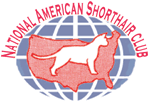
1972 to 1977
The mid-1970s were an exciting time to be showing American Shorthairs. Many new and veteran breeders enthusiastically took their cats to the shows, which often featured 20 to 30 ASH entries.
And the Americans won big, sometimes dominating the finals with three or four in the Top 5. For a number of years, two ASHs annually made CFA’s national Top 10.
Adding to the fun were numerous colors and patterns — solid whites, solid blacks, torties, calicos, tabbies in various colors and both classic and mackerel patterns.
West Coast ASH breeders had a club, American West, but there was no active club in the Midwest or East. Three Midwest breeders talked about starting an ASH club and a newsletter to get the breed news out to people in their region. Adam Frecowski of Adam’s Rib cattery in Chicago was a CFA judge and breeder of top-winning cream tabbies, red tabbies and torties. Mary McIntyre of Saren-Del cattery in Mequon, Wis., was specializing in silver mackerel tabbies. Rosemary Kendrick of Silver Myne cattery in Madison, Wis., was beginning to breed and show silver classic tabbies. Other breeders in the region became interested and soon the group included Mary Jo Mersol, Kay McQuillen, Ellin Dunsworth, Virginia (Ginny) Wolfe and Fonny Miller.
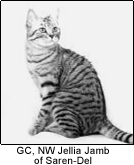
The application for the American Shorthair Mid-West Cat Club, Inc. was submitted to CFA on June 10, 1972,and was accepted at CFA’s June 15, 1972 annual meeting.
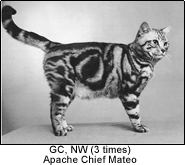
Breeders from around the country began petitioning for club membership. In 1974 a new constitution, removing Midwest residency requirements, was written and accepted. Alayne Poeltl of Apache cattery in New York state was showing the glorious GC, NW Apache Chief Mateo and was a high-profile new member of the club. During this time Mateo was shown nationwide as were Adam Frecowski’s GC, NW Rococo Ruby Petunia of Adam’s Rib and Mary McIntyre’s GC, NW Jellia Jamb of Saren-Del. These three cats often were in the same Top 5 final.
In 1975, the club voted to award a breed rosette in one allbreed ring per show. The first was won by Ruby Petunia, the second by GC Saren-Del’s Toma. In 1976, under club President Mary McIntyre, “state coordinators” were appointed to facilitate more contributions to the newsletter.
Rosemary Kendrick became the new editor of the American Shorthair Mid-West newsletter in 1976, taking over from Linda Seals. She sent out her first issue on January 1, 1977. In the words of Mary Jo Mersol-Barg of Sol-Mer cattery, writing in the July 1992 issue, “Rosemary brought her experience in journalism to the newsletter and turned it into one of the most admired and appreciated newsletters in CFA.”
Each issue addressed controversial breed questions. In the July 1977 issue, for example, breeders weighed in on a hot topic — their interpretation of the proper ASH profile. At the time, the standard was open to broad interpretation. Alayne Poeltl wrote that “ASH breeders have to be careful not to breed to the extreme. The standard calls for a ‘gentle curve’ — we are getting almost a nose break in some cases.”
In 1977, members nationwide called for a change in the name of the club. Rosemary sent out a questionnaire on the topic.
1978…
At a February 1978 meeting of club officers and members, the name was changed to National American Shorthair Club, in accord with members’ wishes as expressed in returned questionnaires.
The newsletter was renamed The American Connection, and the first edition under that name was published on May 20, 1978. It was only one sheet, with masthead art created by Allan Kienzle and a drawing of a cat in a window created by his partner, Dan Simon.
That first American Connection announced the show year’s club winners and also addressed a tragedy that had occurred in April — the unexpected death of club President Adam Frecowski at age 37. Allan Kienzle, of Alkia cattery in Chicago, became club president during this sad time. In a bittersweet follow-up, Adam’s cameo tabby male, GC, NW Adam’s Rib Chicago Fire, DM, was named CFA’s national 3rd Best Cat in June.
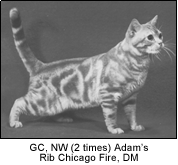
The rosettes given at each show had become quite expensive. Rosemary suggested a breed scoring system with end-of-year awards. The club would send breed ribbons to every show for each ring and recipients would fill out an attached form and return it to the club’s awards chairperson. But soon this also proved costly and unwieldy. So the club asked members to keep track of their own breed wins and report them. The money saved was applied to the club’s CFA Yearbook ad, a club brochure, and rosettes for the annual winners.
In following newsletters, the ASH show standard was a major topic. The Breed Council in 1978 had proposed that “deep” be deleted from the first sentence of the disqualify section, so that a “nose break” of any kind would be grounds for disqualification. The vote was 35-33. The CFA Board took no action. A serious debate followed among the club’s 82 members via the newsletter, with considerable input. Also, Breed Council Secretary Margot Mellies of Miribu cattery posed a discussion on the pros and cons of the existing open ASH registration.
In November 1979, club members hosted a banquet in honor of newsletter editor Rosemary Kendrick. It was a gala affair held in conjunction with the Windy City show in Chicago.
There were hitches. Rosemary’s banquet dress was stolen from her room before the dinner, so she wore a nightgown lent to her by Mary McIntyre. Allan Kienzle’s cats got locked in the show hall while he was busy with the party plans. However, the wine flowed freely and everyone had such a good time that a yearly club banquet was proposed.
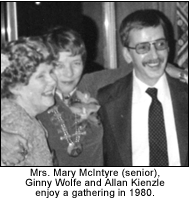
The following year in November, a get-together was held in Milwaukee. The club honored outstanding ASH breeder Virginia Wolfe (Fongin cattery), and it was indeed a night to remember. Twenty-six people attended from all over the United States, as well as Canada.
In November 1981, club members gathered to pay a surprise tribute to Mrs. Mary McIntyre with a banquet at a Milwaukee restaurant. The guest of honor, who was 78, was amazed when Allan revealed the real purpose of the gathering. Mrs. McIntyre and her daughter, Mary, had been breeding ASHs since 1965, including many top winners.
Meanwhile, wide variety in color and pattern characterized the NASC’s Top 10 cats — not only silver tabby and brown tabby but patched tabby, red mackerel tabby, cameo tabby, calico, bi-color and so forth. The newsletter ran a series of articles about the challenges and joys of working with some of the “minority” colors.
1978…
At a February 1978 meeting of club officers and members, the name was changed to National American Shorthair Club, in accord with members’ wishes as expressed in returned questionnaires.
The newsletter was renamed The American Connection, and the first edition under that name was published on May 20, 1978. It was only one sheet, with masthead art created by Allan Kienzle and a drawing of a cat in a window created by his partner, Dan Simon.
That first American Connection announced the show year’s club winners and also addressed a tragedy that had occurred in April — the unexpected death of club President Adam Frecowski at age 37. Allan Kienzle, of Alkia cattery in Chicago, became club president during this sad time. In a bittersweet follow-up, Adam’s cameo tabby male, GC, NW Adam’s Rib Chicago Fire, DM, was named CFA’s national 3rd Best Cat in June.

The rosettes given at each show had become quite expensive. Rosemary suggested a breed scoring system with end-of-year awards. The club would send breed ribbons to every show for each ring and recipients would fill out an attached form and return it to the club’s awards chairperson. But soon this also proved costly and unwieldy. So the club asked members to keep track of their own breed wins and report them. The money saved was applied to the club’s CFA Yearbook ad, a club brochure, and rosettes for the annual winners.
In following newsletters, the ASH show standard was a major topic. The Breed Council in 1978 had proposed that “deep” be deleted from the first sentence of the disqualify section, so that a “nose break” of any kind would be grounds for disqualification. The vote was 35-33. The CFA Board took no action. A serious debate followed among the club’s 82 members via the newsletter, with considerable input. Also, Breed Council Secretary Margot Mellies of Miribu cattery posed a discussion on the pros and cons of the existing open ASH registration.
In November 1979, club members hosted a banquet in honor of newsletter editor Rosemary Kendrick. It was a gala affair held in conjunction with the Windy City show in Chicago.
There were hitches. Rosemary’s banquet dress was stolen from her room before the dinner, so she wore a nightgown lent to her by Mary McIntyre. Allan Kienzle’s cats got locked in the show hall while he was busy with the party plans. However, the wine flowed freely and everyone had such a good time that a yearly club banquet was proposed.

The following year in November, a get-together was held in Milwaukee. The club honored outstanding ASH breeder Virginia Wolfe (Fongin cattery), and it was indeed a night to remember. Twenty-six people attended from all over the United States, as well as Canada.
In November 1981, club members gathered to pay a surprise tribute to Mrs. Mary McIntyre with a banquet at a Milwaukee restaurant. The guest of honor, who was 78, was amazed when Allan revealed the real purpose of the gathering. Mrs. McIntyre and her daughter, Mary, had been breeding ASHs since 1965, including many top winners.
Meanwhile, wide variety in color and pattern characterized the NASC’s Top 10 cats — not only silver tabby and brown tabby but patched tabby, red mackerel tabby, cameo tabby, calico, bi-color and so forth. The newsletter ran a series of articles about the challenges and joys of working with some of the “minority” colors.
1983…
Allen Kienzle was honored at a Chicago area banquet in early 1983. He was launching his new career as a CFA judge and had stepped down as NASC president. Like all of the club dinners, this event was a rather dressy affair in keeping with the tradition of CFA regional and annual banquets.
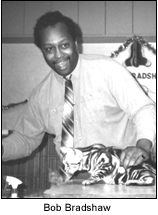
Bob Bradshaw, an ASH breeder (Fesenbrad cattery) and judge from Chicago, succeeded Allan as club president — a post Bob would hold for 10 years.
Beginning with the 1983-84 show season, the NASC annual awards program followed CFA’s system by basing awards on total show points. The totals now came directly from CFA’s computer.
The April 1984 newsletter brought news that the ASH Breed Council had voted 27-12 to close registration, and the CFA Board had approved this proposal. So after May 1 of the following year, only pedigreed Americans of known, registered parents would be allowed to be registered.
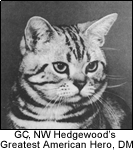
In June 1984, American Shorthair fans were thrilled when GC, NW Hedgewood’s Greatest American Hero was named CFA’s Cat of the Year! He was a silver tabby male bred and owned by Gar and Ande DeGeer of Georgia. “Mr. H” became a Distinguished Merit sire.
Thirty people congregated in August 1984 in Zion, Ill., to honor the younger Mary McIntyre for her important contributions to the breed and club. Allan organized the event and Bob was master of ceremonies. The banquet took place in a beautiful room with a stunning view of Lake Michigan.
Club dinners were also held in or near Chicago in November 1985 and November 1986. At both events, popular breeder Mary Bruesch of Timari cattery was applauded for her wonderful efforts in connection with the club’s prize-winning breed booth.
Another club project at the time was the creation of flashy red, white and blue laminated signs promoting the breed and the club. Each member received several of these cards, made for placing on the front of their American Shorthairs’ cages at shows. NASC member Jasmine (Tucker Kihn) Holt, who had donated rosettes for the club awards program for several years, printed and laminated 600 signs at no cost to the club.
Also, the club was publishing attractive fliers — both one-sided and two-sided versions — with breed information and illustrations.
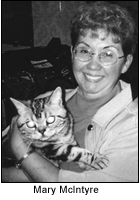
In February 1985, the CFA Board upheld closed ASH registration despite a new 24-15 vote by the Breed Council in favor of open registration — a dramatic reversal of the council’s previous stand. During 1985, Mary McIntyre wrote a series of newsletter articles discussing this topic. In October, Mary reported on the results of questionnaires she had sent out to ASH people. While the majority of the 74 respondents favored some form of open registration, a compromise was sought to address the possible negative results of open registration without safeguards. Later in 1985, Breed Council members approved, 38-9, a compromise draft to reopen ASH registration with several stringent conditions. As a result, in February 1986 the CFA Board approved the proposal, and ASH registration was again opened.
The first ASH breakfast was organized by Breed Council Secretary Gar DeGeer in conjunction with the June 1986 CFA Annual. In following years the breakfast would become an annual tradition — a meeting of NASC and ASH Breed Council members to honor winners of the club’s annual awards and discuss breed issues.
Meanwhile, the ASH show standard became a topic of lively discussion. The standard had been written in the late 1960s by CFA Board member and judge Jane Martinke. The standard’s author was not an American Shorthair breeder and its generalities allowed judges vast leeway in their choices. Consequently, winning ASHs varied from extreme hybrid-appearing cats to those with plain type. In the late 1970s, a more breed-specific standard had been proposed by breed authority Valerie Anne Edwards (Crown E cattery), but it was rejected by the CFA Board.
A five-page questionnaire was sent to club and Breed Council members in August 1986, under Mary McIntyre’s leadership. Seventy-seven percent of respondents favored reorganizing and tightening the standard. Even more opinions were sought, and letters pro and con flooded the newsletter. Valerie reworked her 1970s standard, taking people’s comments into serious consideration, for placement on that fall’s Breed Council ballot.
Breed Council members approved the proposed new standard 50-10, and the CFA Board adopted it in February 1987. Thus the efforts of Mary, Valerie, and the many other people who participated in the discussions, point by detailed point, paid off.
1988…
In 1988, there was a movement to return to the previous standard, but a mailed-out survey showed 84 percent support for the new standard. It was reported that a CFA Board member said the ASH breeders should take pride in the fact that the new ASH standard was being used as a model for revisions of other breed standards.
NASC sponsored a two-ring ASH specialty show — the brainchild of club President Bob Bradshaw — in August 1988. It was held in conjunction with the Abyssinian Midwest Breeders show in Elgin, Ill. The judges were Allan Kienzle and Olen Wilford, another well-known ASH breeder (Soledad cattery). The show was a tremendous success and was followed by a banquet.
Rosemary Kendrick’s newsletters, besides club business, breeder profiles and many photos, posed questions to readers — and the response was enthusiastic. Often 30 or more replies would come in to questions such as: Should we bathe our ASHs before a show? Does inbreeding ASHs work out? Do you give FeLV shots? Club membership rose to almost 200.
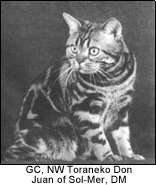
In June 1989, the CFA Annual Convention was held in Milwaukee — and 60 American Shorthair people from around the country gathered at the McIntyre home in nearby rural Mequon for a festive tent party and meeting. After a delicious supper hosted by the McIntyres and Joan Ehlert of Silvrleaf cattery in nearby Germantown, club awards were presented.
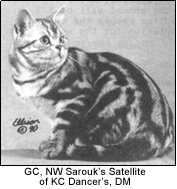
The CFA Invitational Show held in St. Louis in November 1990 was another fantastic event for the NASC and the entire American Shorthair breed. GC Sarouk’s Satellite of KC Dancers, a silver tabby male owned by Craig and Kathy Miller, was Best of the Best in championship and GC Toraneko Don Juan of Sol-Mer, a brown tabby male owned by Mary Jo and Michael Mersol-Barg, was 2nd Best of the Best in championship — out of 384 cats.
Both Satellite and Don Juan went on to become national winners and Distinguished Merit sires. Don Juan was CFA’s national 2nd Best Cat that show year, and Satellite was 5th Best Cat.
Allan Kienzle, longtime club member and club president from 1978 to 1983, passed away in February 1991. He was remembered as a very kind, charming friend to all who knew him. His beautiful shaded silvers were admired by both judges and ASH breeders. Allan’s masthead drawing, signed “AK ’78,” remains at the top of The American Connection’s front page.
In the summer of 1992, Rosemary Kendrick announced that after 16 years as secretary-treasurer and newsletter editor, beginning with the club that was the forerunner to the NASC, she would be passing the torch at the end of the year.
1993…
Gayle Hand of Biamerikitty cattery in California was elected secretary-treasurer in early 1993 and then was appointed newsletter editor. Her first issue included a message from new President Olen Wilford, an article on the pewter tabby, a draft proposal of a revised club constitution (later approved), an article on cat genetics and a tongue-in-cheek advice column.
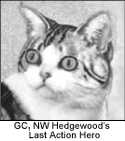
Most importantly, it was reported that various colors of tabby and white had finally won approval from the ASH Breed Council and the CFA Board — a triumph for breeders who had spent many years of effort on this cause. And as a result, a superstar quickly arose: GC, NW Hedgewood’s Last Action Hero, a silver tabby and white male bred and owned by Ande and Gar DeGeer, was named CFA’s 6th Best Kitten in 1994 and CFA’s 12th Best Cat in 1995.
The Summer 1993 issue included a new emphasis on regional reports, with news from the United States and Japan, where ASHs were becoming increasingly popular. Subsequent newsletters in 1994 addressed issues such as failure to conceive in the American Shorthair, eye color genetics, and the pros and cons of recognizing the ticked tabby.
In 1995, Gayle wrote of the suddenly occurring problem of hypertrophic cardiomyopathy in an article titled “The Sudden Death of Young American Shorthairs from Several Different Catteries Is a Cause for Concern.” A plea was made for testing and for the pooling of information. Also, parts of Valerie Anne Edwards’ unpublished book on the ASH were printed.
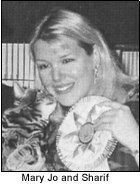
The CFA International Cat Show in November 1995 saw Mary Jo and Michael Mersol-Barg’s GC Sol-Mer Sharif, a brown tabby male, named overall Best in Show, while Dawn Skupin and Eve Russell’s Stedam’s All-American, a brown tabby male, earned Best of the Best Kitten.
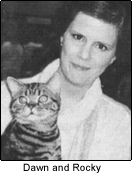
Even bigger honors awaited. Sharif became CFA’s Cat of the Year for 1995-96 — a culmination of Mary Jo’s long and successful involvement with ASHs. And All-American (“Rocky”) became a national winner and Distinguished Merit sire, helping launch Dawn’s Stedam cattery on an amazing run of grands, DM producers, and breed, regional and national wins.
Another great cat, a silver tabby, also came on the scene from Carolyn Lyons’ Placer cattery in California. GC, NW Placer’s Purrfect Salute, DM, became CFA’s highest producing ASH sire of grand champions and grand premiers. Top wins and DMs multiplied. GC Sarouk’s Sundi of Placer, DM, holds the record of most grands for any female of any breed.
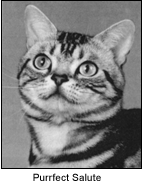
Starting in early 1997, the positions of club secretary-treasurer and editor were separated. When Gayle Hand stepped down, Wayne Crabbs of Rainbo Rebel cattery in California was elected secretary-treasurer and Paul Patton of Luvlypurr cattery in Illinois was appointed editor. Joan Pocica of Chanti cattery in Illinois became club president.
1998…

The Summer 1998 newsletter announced that Rosemary Kendrick would be returning as editor. Joan appointed a committee to review membership rules, and recommendations were subsequently made for changes in the constitution and bylaws to clarify club membership policies.
With the January 1999 newsletter, Rosemary re-introduced a forum feature that drew comments from club members. Among topics that year: What bloodlines are you working with, and why? How do you keep a campaigned cat from becoming bored and/or grumpy? How do you keep your cat numbers down?
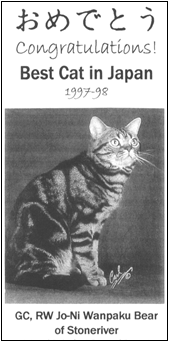
Also, feature articles about individual ASH breeders and their cats became a strong focus of the newsletter. And more attention was paid to the club’s growing number of Japanese members (who also established an ASH club in Japan) and their cats, with some newsletter greetings being printed in the Japanese language.

Ande DeGeer of Georgia was elected club president in 1999. She announced the expansion of a website for the club and the ASH Breed Council. Through the years Ande has continued to expand and improve the site (www.ashclub.org).Later she reported that to celebrate CFA’s registration of the first American Shorthair in 1900, club officers were making plans for a special event — co-sponsorship of the August 2000 Hotlanta cat show in Macon, Ga.
Wrestling with rising costs, the NASC officers found a corporate co-sponsor. The Iams Company pledged $500 for the Macon show, plus considerably larger contributions toward the club’s June breakfasts and club awards. The company’s generous assistance to the NASC continued for a number of years, and it allowed the club to present top-quality awards.
The Macon show proved to be an outstanding success, with 46 ASHs entered. In championship alone, 21 out of the 60 final placings (six rings x 10) went to American Shorthairs. Each Top 10 final included between three and five Americans. Each of the four allbreed rings had an ASH as Best Cat — four different cats! One of the shorthair rings also had an ASH as Best Cat, and the other had an ASH as 2nd Best Cat.
In July 2002, Rosemary notified the club officers that she would be stepping down as newsletter editor at the end of the year. In her resignation letter, she wrote that at age 62, she was aware that a person’s “time isn’t endless, as it once seemed,” and she wanted to try some new things. Rosemary had been newsletter editor in two phases for a total of 20 years, plus an additional year (1977) before there was a National American Shorthair Club and American Connection.
2003 to 2008

Kristy Ditzler of Taz-n-Toonce cattery in Austin, Texas, stepped in as the new editor. In her capable hands, the newsletter continued to be the glue that binds American Shorthair enthusiasts together.
Kristy, a silver tabby breeder, put new emphasis on ASH winners and exhibitors at the major shows. She also added quarterly updates of ASH national point standings. A new regular column was introduced: the Rescue Connection, with club members’ touching personal stories about cats less fortunate than our pampered purebreds.
In October 2005, the Rescue Connection featured a dramatic story in which Erin Russell (Russellers cattery) told how she and her family and animals fled as Hurricane Katrina barreled down on them in New Orleans. They made it to Alabama, leaving behind a ruined home. Erin wrote with gratitude about “all the support I got from the ASH people! Many people have offered to take in cats and have asked me if I needed anything over and over again.”
Among club developments in recent years:
- The American Shorthair Historical Archives Project, led by Dawn Skupin with assistance from Valerie Anne Edwards, collected pedigrees of ASH national winners and DMs.
- In August 2005 the club co-sponsored the Mk-Kan “All-American” show.
- Attractive, colorful club pins became available for $5.
- The Iams Company’s sponsorship of club awards ended after 2006. Subsequently the NASC board voted to raise dues to $25 per year ($35 outside U.S. and Canada) beginning in 2008.
Several longtime, well-known ASH breeders passed away, including Bob Bradshaw, Wayne Park (Norpark cattery), Robert Kreft (Kaarja), Joann Elwyn Sneed Landers (Joelwyn), Jean Belvel Richter (Avanti), Margot Williams (Portrait) and Alayne Poeltl Tyldsley (Apache).
Mary McIntyre announced in late 2006 that she would not seek re-election to the NASC board. She had served as an officer/board member since the club’s founding.
Carol Johnson of Melodygarden cattery succeeded Bob Zenda (Tsu-Kee-Ah-Kee) as ASH Breed Council secretary in 2007.
In late 2007, Ande and Rosemary began work on a massive project to scan all past newsletters and post them on the NASC Web site so our club and breed’s detailed history will be preserved.
The years have been lively, educational, fun, occasionally contentious, never boring. Many friendships formed and endured. Triumphs were cheered, tragedies were mourned, support was generously given.
Through it all, club members’ beautiful, loving and unforgettable cats always held center stage.
The above article was prepared by Mary McIntyre and Rosemary Kendrick with help from the writings of Valerie Anne Edwards and Mary Jo Mersol-Barg — and three decades of newsletters.